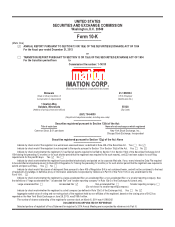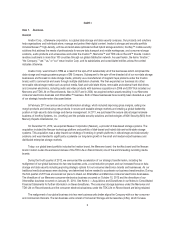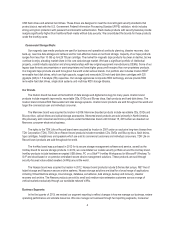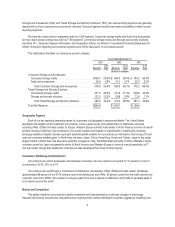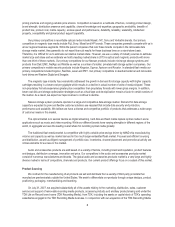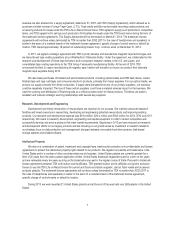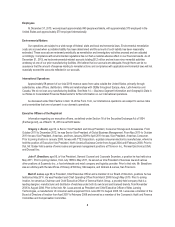Memorex 2013 Annual Report Download - page 13
Download and view the complete annual report
Please find page 13 of the 2013 Memorex annual report below. You can navigate through the pages in the report by either clicking on the pages listed below, or by using the keyword search tool below to find specific information within the annual report.competing formats as well as continuing improvements in compression and deduplication technologies. While demand for
data capacity is expected to increase, removable magnetic media market size is expected to decrease in terms of revenue. If
we are not successful in growing new product revenues, including revenues related to our recent acquisition of Nexsan and
revenues from our portable workspace solutions, our financial results could be negatively impacted.
Because of the rapid technology changes in our industry, we may not be able to compete if we cannot quickly
develop, source, introduce and deliver differentiated and innovative products. We operate in a highly competitive
environment against competitors who are both larger and smaller than us in terms of resources and market share. Our
industry is characterized by rapid technological change and new product introductions. In these highly competitive and
changing markets, our success will depend, to a significant extent, on our ability to continue to develop and introduce
differentiated and innovative products cost-effectively and on a timely basis. The success of our offerings is dependent on
several factors including our differentiation from competitive offerings, timing of new product introductions, effectiveness of
marketing programs and maintaining low manufacturing, sourcing and supply chain costs. No assurance can be given with
regard to our ability to anticipate and react to changes in market requirements, actions of competitors or the pace and
direction of technology changes.
We may be dependent on third parties for new product introductions or technologies in order to introduce our
own new products. We are dependent in some cases upon various third parties for the introduction and acceptance of
new products, the timing of which is not entirely in our control. In addition, there can be no assurance that we will maintain
existing relationships or forge new OEM relationships. There can also be no assurance that we will continue to have access to
proprietary technologies through internal development and licensing arrangements with third parties, or that we will continue
to have access to new competitive technologies that may be required to introduce new products. If we are not successful in
maintaining and developing new relationships with OEMs or obtaining rights to use competitive technologies, we may become
less competitive in certain markets.
If we do not successfully implement restructuring plans and realize the benefits expected from the
restructuring, our financial results will be affected. From time to time we have initiated restructuring programs related to
our business strategy to, among other things, reduce operating expenses and address product line rationalization and
infrastructure. We may not be able to realize the expected benefits and cost savings if we do not successfully implement
these plans. If we are unable to restructure our operations successfully as needed, or on a timely basis, our expectations of
future results of operations, including certain cost savings expected to result from the restructuring, may not be met. If
difficulties are encountered or such cost savings are otherwise not realized, it could have a material adverse effect on our
business, financial condition and results of operations.
Our international operations subject us to economic risks including risk of foreign currency fluctuations and
negative or uncertain global or regional economic conditions could adversely affect our business and operating
results. We conduct our business on a global basis, with approximately 59 percent of our 2013 revenue derived from
operations outside of the United States. Our international operations may be subject to various risks which are not present in
domestic operations, including political and economic instability, terrorist activity, the possibility of expropriation, trade tariffs or
embargoes, unfavorable tax laws, restrictions on royalties, dividend and currency remittances, changes in foreign laws and
regulations, requirements for governmental approvals for new ventures and local participation in operations such as local
equity ownership and workers’ councils. In addition, our business and financial results are affected by fluctuations in world
financial markets. Changes in local and regional economic conditions, including fluctuations in exchange rates, may affect
product demand in our non-U.S. operations and export markets. Additionally, some of our suppliers pay us quarterly or annual
rebates based on the amount of purchases we make from them. If negative conditions in the global credit markets prevent our
customers’ access to credit, product orders in these channels may decrease, which could result in lower revenue. Likewise,
our suppliers may face challenges in obtaining credit, in selling their products or otherwise in operating their businesses.
Foreign currency fluctuations can also affect reported profits of our non-U.S. operations where transactions are generally
denominated in local currencies. A recession in any of the regions we serve might affect product demand and cause
fluctuations in exchange rates. In addition, currency fluctuations may affect the prices we pay suppliers for materials used in
our products. Our financial statements are denominated in U.S. dollars. Accordingly, fluctuations in exchange rates, including
exchange rate volatility in the Euro and the Japanese Yen, may give rise to translation gains or losses when financial
10


